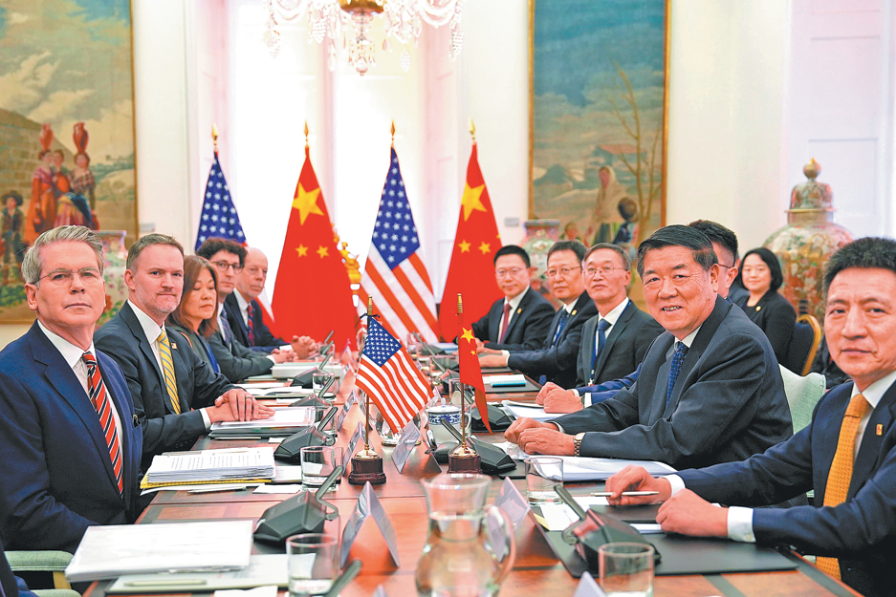US nuclear-sub crash in S. China Sea raises questions
By HENG WEILIin New York | China Daily Global | Updated: 2021-11-03 10:47

The US Navy is further investigating the crash of a US nuclear submarine in the South China Sea last month.
The USS Connecticut struck an "uncharted seamount" on Oct 2, which injured several crew members. The 7th Fleet, which operates in the western Pacific Ocean, found after an investigation that there had been no foul play in the incident, concluding that the sub hit a mountain rising from the sea bed. The Navy did not report the accident until five days later.
A current release on the 7th Fleet website says: "The command investigation for USS Connecticut (SSN 22) has been submitted to Commander, US 7th Fleet for review and endorsement. The investigation determined that Connecticut grounded on an uncharted seamount while operating in international waters in the Indo-Pacific region. Commander, US 7th Fleet will determine whether follow-on actions — including accountability — are appropriate."
The commander is Vice-Admiral Karl Thomas.
A seamount is "an underwater mountain formed by volcanic activity", according to the National Oceanic and Atmospheric Administration.
USNI News, published by the US Naval Institute, reported that there were some moderate to minor injuries to crew in the accident. It said the crash damaged the submarine's forward ballast tanks and forced it to sail on the surface for a week to Guam for repairs.
"Connecticut is one of three Sea Wolf-class attack nuclear boats that were developed for deep-water operations to take on Soviet submarines in the open ocean. Since the end of the Cold War, the trio has been upgraded and modified to carry out some of the Navy's most sensitive missions," USNI wrote.
The Connecticut is a Seawolf-class nuclear-powered, fast-attack submarine. The $3 billion vessel was built by the Electric Boat Division of General Dynamics Corp at Groton, Connecticut, and launched on Sept 1, 1997. The 353-foot vessel, which is homeported in Washington state, was commissioned in 1998 and has a crew of 116, including 15 officers. It can carry 40 torpedoes or missiles.
When the Navy reported the accident last month, it said only that the Connecticut had "struck an object while submerged".
"It's very rare for this to happen," Bryan Clark, a former US Navy submarine warfare officer and defense expert at the Hudson Institute, told Business Insider. "There's a lot of careful planning that goes into these operations."
Clark said, "the charts of a place like the South China Sea (which is shallow) may not be nearly as detailed as you want".
If a submarine is trying to be quiet and undetected, it would likely be closer to the bottom and not using sonar, which can alert it to any potential dangers, such as naval mines, but also would alert potential adversaries to its position, Clark told Insider.
A Chinese Foreign Ministry spokesman on Tuesday expressed concern about a "lack of transparency and lack of responsibility from the US".
"What we have seen is that nearly a week after the incident, the US issued an evasive statement, saying the submarine hit an unknown object. Nearly a month after the incident, it said the submarine grounded on an uncharted seamount," Foreign Ministry spokesman Wang Wenbin said at a news briefing Tuesday.
"It also deliberately used the sweeping term 'international waters in the Indo-Pacific region' and has yet to give clear answers to questions like the intention of the operation, the exact location of the incident, whether it lies in the exclusive economic zone or territorial sea of any country, whether the collision led to a nuclear leak or polluted the marine environment, all cause for great concern and doubt," Wang said.
"We once again urge the US to give a detailed description of the incident and fully address regional countries' concern and doubt," he said. "The key is to stop deploying military aircraft and warships to harass and provoke others and flex muscles, and to stop harming other countries' sovereign security, otherwise it will be inviting more, not fewer, similar incidents."
The US Navy has not said where in the sea the collision with the seamount occurred.
























